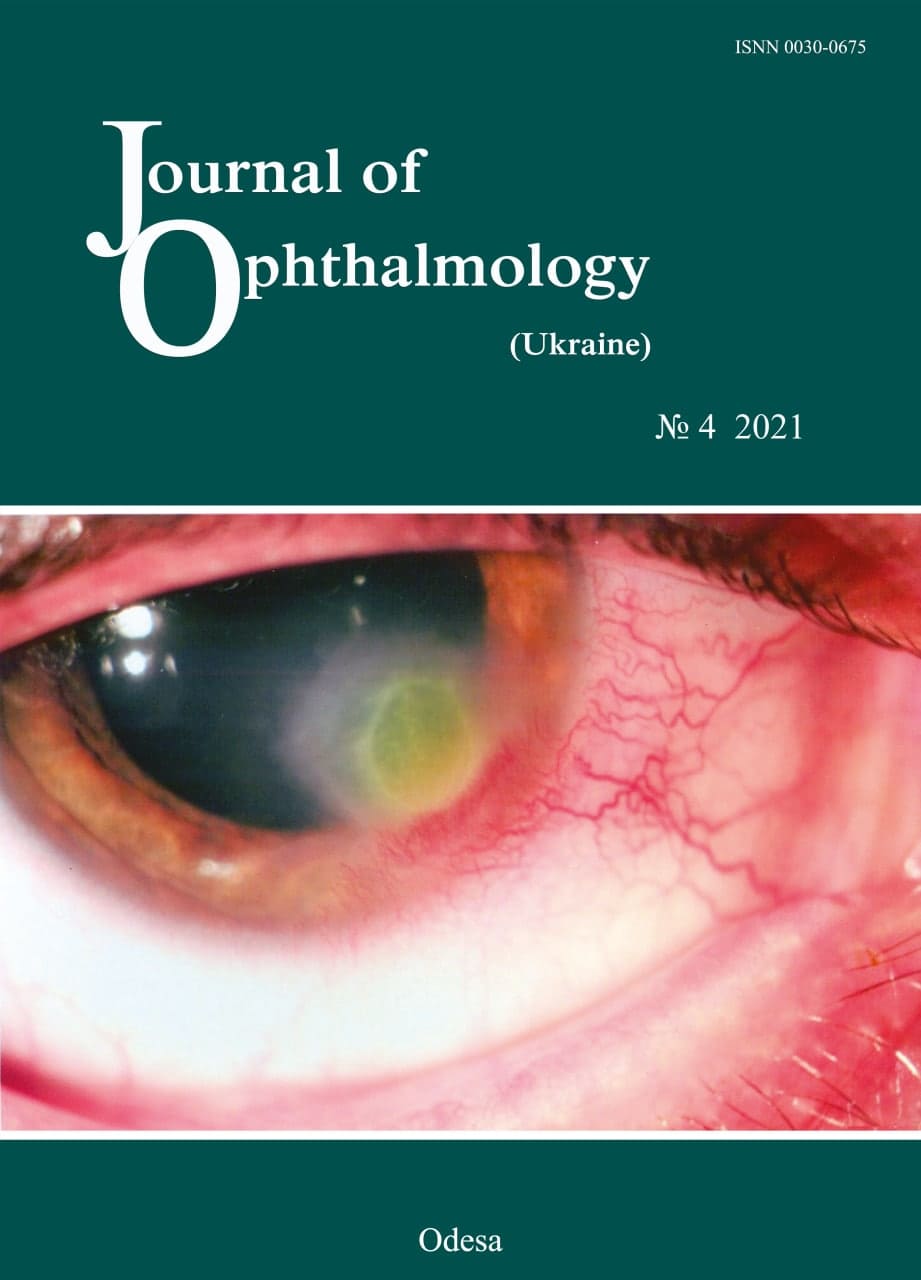Predicting DME recurrence following surgical treatment for diabetic maculopathy in a Ukrainian population of patients with type 2 diabetes mellitus
DOI:
https://doi.org/10.31288/oftalmolzh20214918Keywords:
diabetic macular edema, surgical treatment, recurrences, rs1800629, rs1800818, PDGF-ВВ, TNFα, type 2 diabetes mellitusAbstract
Background: Recurrent diabetic maculopathy (DMP) and diabetic macular edema (DME) may develop in the early or late period even after an advanced vitreoretinal procedure. It has been reported that the recurrence rate at one month and at one year after vitreoretinal surgery varied from 6.6% to 20.8% and from 20.8% to 83.3%, respectively.
Purpose: To develop a model for predicting recurrence of DME after surgical treatment for DMP in the Ukrainian population of patients with type 2 diabetes mellitus (T2DM).
Material and Methods: The study included 313 patients with T2DM (313 eyes) who underwent various types of vitreoretinal surgery. Preoperatively, enzyme-linked immunosorbent assays were used to determine blood PDGF-BB, TNFα and ЕТ1 levels, and polymorphisms of PDGFB (rs1800818) and TNFα (rs1800629) were investigated by real-time polymerase chain reaction. At months 1, 3, 6 and 12 after surgery, incidence of DME recurrence and associations of DME recurrence with the characteristics under study were assessed. Multivariate logistic regression analysis was used to develop a model in Statistica 10 (GLZ; StatSoft, Tulsa, OK, USA).
Results: Index of diabetic macular edema progression (DMEI) was used as the dependent variable and calculated as the mean speed of change in central retinal thickness (CRT) over a year after the initiation of treatment for DMP. SNP rs1800818 in PDGFB, SNP rs1800629 in TNFα, blood PDGF-BB level, and CRT0 were found to be significant predictors of the risk for postoperative DME recurrence. The calculation of DMEI values allowed to divide possible genotype combinations into three groups: those promoting the regression (СС-GG; CC-GA; TC-GG), those with a stable DMEI value (TC-GA and TC-AA), and those promoting the progression of DME.
Conclusion: The prediction of DME recurrence after various types of vitreoretinal surgery combined with other methods of surgical treatment for DMP in a Ukrainian population of patients with T2DM is based on the determination of gene polymorphisms of PDGFB and TNFα.
References
1.Balashevich LI, Izmailov AS. [Diabetic ophthalmopathy]. St. Petersburg: Chelovek; 2012. Russian.
2.Hu XY, Liu H, Wang LN, Ding YZ, Luan J. Efficacy and safety of vitrectomy with internal limiting membrane peeling for diabetic macular edema: a Meta-analysis. Int J Ophthalmol. 2018 Nov 18;11(11):1848-55.
3.Jackson TL, Nicod E, Angelis A, Grimaccia F, Pringle E, Kanavos P. Pars plana vitrectomy for diabetic macular edema: A System-atic Review, Meta-Analysis, and Synthesis of Safety Literature. Retina. 2017 May;37(5):886-95. https://doi.org/10.1097/IAE.0000000000001280
4.Rinaldi M, dell'Omo R, Morescalchi F, Semeraro F, Gambicorti E, Cacciatore F, et al. ILM peeling in nontractional diabetic macular edema: review and metanalysis. Int Ophthalmol. 2018 Dec;38(6):2709-14.https://doi.org/10.1007/s10792-017-0761-6
5.Doi N, Sakamoto T, Sonoda Y, Yasuda M, Yonemoto K, Arimura N, et al. Comparative study of vitrectomy versus intravitreous triamcinolone for diabetic macular edema on randomized paired-eyes. Graefes Arch Clin Exp Ophthalmol. 2012 Jan;250(1):71-8. doi: 10.1007/s00417-011-1777-7.https://doi.org/10.1007/s00417-011-1777-7
6.Xiao K, Dong YC, Xiao XG, Liang SZ, Wang J, Qian C, Wan GM. Effect of pars plana vitrectomy with or without cataract surgery in patients with diabetes: a systematic review and meta-analysis. Diabetes Ther. 2019 Oct;10(5):1859-68. doi: 10.1007/s13300-019-0672-9.https://doi.org/10.1007/s13300-019-0672-9
7.Panchenko Yu. Effectiveness of different methods of surgical treatment of diabetic maculopathy in patients with type 2 diabetes. American Science Journal. 2019;28(2):27-34.
8.Panchenko Yu. Possibilities and effectiveness of cataract phacoemulsification, closed subtotal vitrectomy and panretinal laser coagu-lation in diabetic maculopathy treatment in patients with type 2 diabetes. East European Science Journal. 2019;7(47 part 2):50-6.
9.Eshaq RS, Aldalati AMZ, Alexander JS, Harris NR. Diabetic retinopathy: Breaking the barrier. Pathophysiology. 2017;24(4):229-41.https://doi.org/10.1016/j.pathophys.2017.07.001
10.Jenkins AJ, Joglekar MV, Hardikar AA, Keech AC, O'Neal DN, Januszewski AS. Biomarkers in Diabetic Retinopathy. Rev Dia-bet Stud. 2015 Spring-Summer;12(1-2):159-95.https://doi.org/10.1900/RDS.2015.12.159
11.Mogilevskyy SIu, Panchenko IuO, Ziablytsev SV. New risk factors for post-surgical recurrent diabetic maculopathy in type 2 dia-betus mellitus. J Ophthalmol (Ukraine). 2019;5(490):9-17.https://doi.org/10.31288/oftalmolzh20195917
12.Kamoi K, Takeda K, Hashimoto K, Tanaka R, Okuyama S. Identifying risk factors for clinically significant diabetic macula edema in patients with type 2 diabetes mellitus. Curr Diabetes Rev. 2013 May;9(3):209-17.https://doi.org/10.2174/1573399811309030002
13.Diep TM, Tsui I. Risk factors associated with diabetic macular edema. Diabetes Res Clin Practice. 2013 Jun;100(3):298-305.https://doi.org/10.1016/j.diabres.2013.01.011
14.Cunha-Vaz J. The blood-retinal barrier in the management of retinal disease: EURETINA Award Lecture. Ophthalmologica. 2017; 237 (1):1-10.https://doi.org/10.1159/000455809
15.Diep TM, Tsui I. Risk factors associated with diabetic macular edema. Diabetes Res Clin Practice. 2013 Jun; 100 (3):298-305.https://doi.org/10.1016/j.diabres.2013.01.011
16.Kamoi K. Identifying risk factors for clinically significant diabetic macula edema in patients with type 2 diabetes mellitus. Curr Dia-betes Rev. 2013; 9 (3):209-17.https://doi.org/10.2174/1573399811309030002
17.Liu C, Feng X, Li Q, Wang Y, Hua M. Adiponectin, TNF-α and inflammatory cytokines and risk of type 2 diabetes. A systematic review and meta-analysis. Cytokine. 2016 Oct; 86:100-9.https://doi.org/10.1016/j.cyto.2016.06.028
18.IRS1 - Insulin receptor substrate 1 - Homo sapiens (Human) - IRS1 gene & protein". Available on: www.uniprot.org. Retrieved 2016-04-21.
19.Takaguri A. Elucidation of a new mechanism of onset of insulin resistance: effects of statins and tumor necrosis factor-α on insulin signal transduction. Yakugaku Zasshi. 2018; 138 (11):1329-34.https://doi.org/10.1248/yakushi.18-00116
20.Copps KD, White MF. Regulation of insulin sensitivity by serine/threonine phosphorylation of insulin receptor substrate proteins IRS1 and IRS2. Diabetologia. 2012; 55 (10):2565-82.https://doi.org/10.1007/s00125-012-2644-8
21.Panchenko YuO. [Tumor necrosis factor-alpha (TNFα) and recurrence of diabetic maculopathy after surgery in patients with type 2 diabetes]. Ophthalmology. 2019; 2:65-76. Ukrainian.https://doi.org/10.30702/Ophthalmology.2019/10.126575
22.Loukovaara S, Piippo N, Kinnunen K, Hytti M, Kaarniranta K, Kauppinen A. NLRP3 inflammasome activation is associated with proliferative diabetic retinopathy. Acta Ophthalmol. 2017 Dec; 95 (8):803-8.https://doi.org/10.1111/aos.13427
23.Loukovaara S, Sandholm J, Aalto K, Liukkonen J, Jalkanen S, Yegutkin GG. Deregulation of ocular nucleotide homeostasis in patients with diabetic retinopathy. J Mol Med (Berl). 2017; 95 (2):193-204.https://doi.org/10.1007/s00109-016-1472-6
24.Raczyńska D, Lisowska KA, Pietruczuk K, Borucka J, Ślizień M, Raczyńska K, et al. The Level of Cytokines in the Vitreous Body of Severe Proliferative Diabetic Retinopathy Patients Undergoing Posterior Vitrectomy. Curr Pharm Des. 2018; 24 (27):3276-81.https://doi.org/10.2174/1381612824666180926110704
25.Luna GI, da Silva IC, Sanchez MN. Association between -308G/A TNFA Polymorphism and Susceptibility to Type 2 Diabetes Mellitus: A Systematic Review. J Diabetes Res. 2016; 2016:6309484.https://doi.org/10.1155/2016/6309484
26.Liu ZH, Ding YL, Xiu LC, Pan HY, Liang Y, Zhong SQ, et al. A meta-analysis of the association between TNF-α -308G>A pol-ymorphism and type 2 diabetes mellitus in Han Chinese population. PLoS One. 2013; 8 (3):e59421.https://doi.org/10.1371/journal.pone.0059421
27.Sesti LF, Crispim D, Canani LH, Polina ER, Rheinheimer J, Carvalho PS, Gross JL, Santos KG. The -308G>A polymorphism of the TNF gene is associated with proliferative diabetic retinopathy in Caucasian Brazilians with type 2 diabetes. Invest Ophthal-mol Vis Sci. 2015 Jan 29; 56 (2):1184-90.https://doi.org/10.1167/iovs.14-15758
28.Dhamodharan U, Viswanathan V, Krishnamoorthy E, Rajaram R, Aravindhan V. Genetic association of IL-6, TNF-α and SDF-1 polymorphisms with serum cytokine levels in diabetic foot ulcer. Gene. 2015 Jul 1; 565 (1):62-7.https://doi.org/10.1016/j.gene.2015.03.063
29.Doody NE, Dowejko MM, Akam EC, Cox NJ, Bhatti JS, Singh P, et al. The role of TLR4, TNF-α and IL-1β in type 2 diabetes mellitus development within a North Indian population. Ann Hum Genet. 2017 Jul; 81 (4):141-6.https://doi.org/10.1111/ahg.12197
30.Panchenko IuO. Value of TNF-α (rs1800629) polymorphism in recurrent maculopathy after surgery in a Ukrainian population of T2DM patients. J Ophthalmol (Ukraine).2019;6:15-22.https://doi.org/10.31288/oftalmolzh201961522
31.Zhao Y, Li Z, Zhang L, Zhang Y, Yang Y, Tang Y, Fu P. The TNF-alpha -308G/A polymorphism is associated with type 2 diabe-tes mellitus: an updated meta-analysis. Mol Biol Rep. 2014 Jan; 41 (1):73-83.https://doi.org/10.1007/s11033-013-2839-1
32.Hameed I, Masoodi SR, Malik PA, Mir SA, Ghazanfar K, Ganai BA. Genetic variations in key inflammatory cytokines exacerbates the risk of diabetic nephropathy by influencing the gene expression. Gene. 2018 Jun 30; 661:51-59. doi: 10.1016/j.gene.2018.03.095.https://doi.org/10.1016/j.gene.2018.03.095
33.Umapathy D, Krishnamoorthy E, Mariappanadar V, Viswanathan V, Ramkumar KM. Increased levels of circulating (TNF-α) is associated with (-308G/A) promoter polymorphism of TNF-α gene in Diabetic Nephropathy. Int J Biol Macromol. 2018 Feb; 107 (B):2113-21.https://doi.org/10.1016/j.ijbiomac.2017.10.078
34.37. Mogilevskyy SIu, Panchenko YuO, Ziablitsev SV, Ziablitsev DS. Influence of local and systemic factors of type 2 diabetes mellitus on the functional status of platelets in patients with diabetic retinopathy and maculopathy. J Ophthalmol (Ukraine). 2018;6:23-9.https://doi.org/10.31288/oftalmolzh201862329
35.Zhang J, Cao R, Zhang Y, Jia T, Cao Y, Wahlberg E. Differential roles of PDGFR-alpha and PDGFR-beta in angiogenesis and vessel stability. FASEB J. 2009 Jan; 23 (1):153-63.https://doi.org/10.1096/fj.08-113860
36.Rodriguez A, Friman T, Kowanetz M, van Wieringen T, Gustafsson R, Sundberg C. Phenotypical differences in connective tissue cells emerging from microvascular pericytes in response to overexpression of PDGF-B and TGF-β1 in normal skin in vivo. Am J Pathol. 2013 Jun; 182 (6):2132-46.https://doi.org/10.1016/j.ajpath.2013.01.054
37.Hata N, Shinojima N, Gumin J, Yong R, Marini F, Andreeff M, Lang FF. Platelet-derived growth factor BB mediates the tropism of human mesenchymal stem cells for malignant gliomas. Neurosurgery. 2010 Jan; 66 (1):144-56; discussion 156 7. https://doi.org/10.1227/01.NEU.0000363149.58885.2E
38.Mori K, Gehlbach P, Ando A, Dyer G, Lipinsky E, Chaudhry AG, et al. Retina-specific expression of PDGF-B versus PDGF-A: vascular versus nonvascular proliferative retinopathy. Invest Ophthalmol Vis Sci. 2002; 43:2001-6.
39.Panchenko YuO, Mogilevskyy SIu, Ziablitsev SV. [The effect of platelet-derived growth factor (PDGF) on the development of relapses in the surgical treatment of diabetic maculopathy in patients with type 2 diabetes]. Archive of Ophthalmology of Ukraine. 2019;7(3):18-23. Ukrainian.
40.Praidou A, Klangas I, Papakonstantinou E, Androudi S, Georgiadis N, Karakiulakis G, Dimitrakos S. Vitreous and serum levels of platelet-derived growth factor and their correlation in patients with proliferative diabetic retinopathy. Curr Eye Res. 2009 Feb; 34 (2):152-61. https://doi.org/10.1080/02713680802585920
41.Park HY, Kim IT, Park CK. Early diabetic changes in the nerve fibre layer at the macula detected by spectral domain optical coher-ence tomography. Br J Ophthalmol. 2011; 95 (9):1223-8. https://doi.org/10.1136/bjo.2010.191841
42.Zhang XA, Guo CT, Lu QB, Hu JG, Cui N, Yang ZD, et al. The platelet derived growth factor-B polymorphism is associated with risk of severe fever with thrombocytopenia syndrome in Chinese individuals. Oncotarget. 2016 May 31; 7 (22):33340-9. https://doi.org/10.18632/oncotarget.9043
43.Stremitzer S, Zhang W, Yang D, Ning Y, Stintzing S, Sebio A, et al. Genetic variations in angiopoietin and pericyte pathways and clinical outcome in patients with resected colorectal liver metastases. Cancer. 2015 Jun 1;121(11):1898-905. https://doi.org/10.1002/cncr.29259
44.Panchenko YuO. [Association of rs1800818 PDGFB gene polymorphism with recurrence of diabetic maculopathy after surgery in patients with type 2 diabetes]. Bulletin of problems of biology and medicine. 2019;4;1(153):138-42. [Ukranian] https://doi.org/10.29254/2077-4214-2019-4-1-153-138-142
Downloads
Published
How to Cite
Issue
Section
License
Copyright (c) 2025 Ю. А. Панченко , С. Ю. Могилевский , С. А. Рыков , Д. Г. Жабоедов , М. М. Уманец , С. В. Зяблицев

This work is licensed under a Creative Commons Attribution 4.0 International License.
This work is licensed under a Creative Commons Attribution 4.0 International (CC BY 4.0) that allows users to read, download, copy, distribute, print, search, or link to the full texts of the articles, or use them for any other lawful purpose, without asking prior permission from the publisher or the author as long as they cite the source.
COPYRIGHT NOTICE
Authors who publish in this journal agree to the following terms:
- Authors hold copyright immediately after publication of their works and retain publishing rights without any restrictions.
- The copyright commencement date complies the publication date of the issue, where the article is included in.
DEPOSIT POLICY
- Authors are permitted and encouraged to post their work online (e.g., in institutional repositories or on their website) during the editorial process, as it can lead to productive exchanges, as well as earlier and greater citation of published work.
- Authors are able to enter into separate, additional contractual arrangements for the non-exclusive distribution of the journal's published version of the work with an acknowledgement of its initial publication in this journal.
- Post-print (post-refereeing manuscript version) and publisher's PDF-version self-archiving is allowed.
- Archiving the pre-print (pre-refereeing manuscript version) not allowed.












